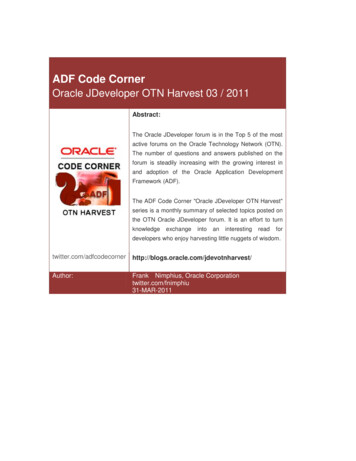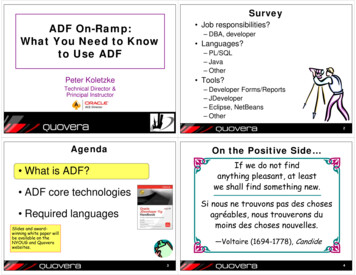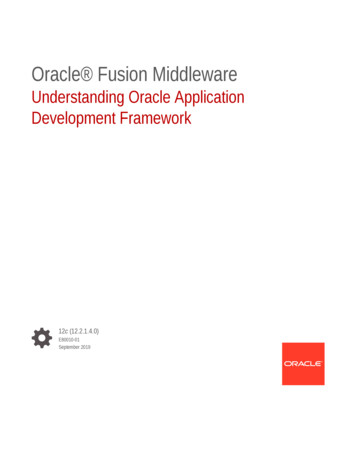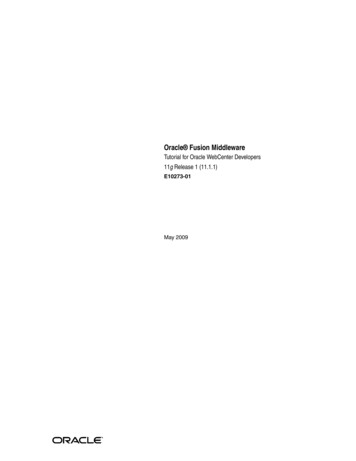
Transcription
ADF Code CornerOracle JDeveloper OTN Harvest 03 / 2011Abstract:The Oracle JDeveloper forum is in the Top 5 of the mostactive forums on the Oracle Technology Network (OTN).The number of questions and answers published on theforum is steadily increasing with the growing interest inand adoption of the Oracle Application DevelopmentFramework (ADF).The ADF Code Corner "Oracle JDeveloper OTN Harvest"series is a monthly summary of selected topics posted onthe OTN Oracle JDeveloper forum. It is an effort to opers who enjoy harvesting little nuggets of wisdom.twitter.com/adfcodecorner k Nimphius, Oracle Corporationtwitter.com/fnimphiu31-MAR-2011
OTN ORACLE JDEVELOPER FORUM HARVESTADF CODE CORNER 3 / 2011Oracle ADF Code Corner isOTNa looseHarvestblog-styleis aseriesmonthlyof how-toblog seriesdocumentsthat publishesthat providehow-tosolutionstipsto realandinformationworld codingaroundproblems.Oracle JDeveloper and Oracle ADF.Disclaimer: AllADFsamplesCode areCornerprovidedOTNasHarvestis with nois aguaranteeblogging effortfor futureaccordingupgradesto theor Oracleerrorcorrection.policies.bloggingNo supportIt is notcananbeofficialgiven throughOracle publication.Oracle customerAll samplessupport. and code snippets areprovided "as is" with no guarantee for future upgrades or error correction. No support can bePleasethroughgivenpost questionsOracle customeror report support.problems related to the samples in this series on the OTN forumfor Oracle JDeveloper: http://forums.oracle.com/forums/forum.jspa?forumID 83If you have questions, please post them to the Oracle OTN JDeveloper orumID 83March 2011 Issue – Table of ContentBest-practice for follow-up questions on OTN forums . 3How-to display JavaDocs for methods displayed in syntax help . 3"Internal Package Import" errors and how to switch them off . 4Building model driven dependent list with Oracle ADF BC. 6How to display a dependent list box disabled if no child data exist . 12Testing bounded task flow using page fragments . 14Oracle JDeveloper command line arguments . 14Task flow "new transaction" vs. "new db connection" . 14Configuring the ADF BC locking behavior in JDeveloper 11.1.1.4 . 18How-to filter table filter input to only allow numeric input . 18Best practices about creating and using backing beans . 22Extending the ADF Controller exception handler . 22How to create a model-driven multi column auto-suggest list . 23How-to delete a tree node using the context menu . 26How to open the LOV of af:inputListOfValues with a double click . 30Configuring projects for Java EE security annotations . 32Implementing Query pagination using EJB and ADF . 33How to equally stretch multiple table columns . 342
OTN ORACLE JDEVELOPER FORUM HARVESTADF CODE CORNER 3 / 2011Best-practice for follow-up questions on OTN forumsI recently recognized users on the OTN forum to post a question to then, when answers are coming in,change subject to follow up questions that are not related to the previously asked question. The problemwith changing subject in an OTN thread is that the follow up questions are stealth and not seen by manyon the forum who don't read until the end of a thread but go with the subject mention in the header.In addition, those who provided a correct answer to the original question, considering the question asanswered and move on. So the obvious negative impact of stealth follow questions in a forum thread isthat no one looks at it no matter how hard user bump it back to the top of the list. Therefore, if you havea follow up question on an original question that however changes subject, post it in a new thread. Its fiveminutes of your time to re-phrase the question to the new subject saving you days you spend waiting withno answer.How-to display JavaDocs for methods displayed in syntax helpWhen working within the Oracle JDeveloper Java code editor, syntax help is displayed when pausing youredits after adding a dot (".") or when pressing ctrl blank key for the incomplete statement.However, unless you are savvy with the component API you are working with, not all the methods mayspeak to you. To get an idea of what a specific method can do for you, you can enable quick Java docs tobe displayed. To open the Java documentation for the selected method, click the little plus icon next tothe QuickDoc label at the lower right corner of the method completion dialog as shown in the imagebelow.The Java doc window stays open and changes its content with you changing the selection on the methoddialog. To close the Java documentation window, click the minus icon next to QueickDoc label or press thectrl d keyboard shortcut.3
OTN ORACLE JDEVELOPER FORUM HARVESTADF CODE CORNER 3 / 2011"Internal Package Import" errors and how to switch them offA new functionality in Oracle JDeveloper 11g (11.1.1.4) is an audit rule that flags an error when compilingJava files that use internal ADF framework classes. Internal ADF framework classes are public classes thatreside in internal packages. For example, FacesCtrlHierBinding extends JUCtrlHierBindingand represents the component model used with the ADF Faces table, tree and tree table components. It isan internal implementation class that developers should not use in their application development. For thisreason, Oracle packaged it in a package structure with the name internal in esCtrlHierBinding.Similar package structures exist for Oracle ADF Business Components, ADF Controller and othertechnologies in Oracle ADF. In previous versions of Oracle JDeveloper 11g, this audit rule did not exist,which means that without noticing, developers may have used those classes, which now, after upgradingADF applications to Oracle JDeveloper 11.1.1.4, no longer compile, because the new audit rule preventsit from compiling. So there are reasons for you to want the audit rule to change. To change the audit rulesettings for internal framework class uses, to either disable (less recommended) or smoothen it (morerecommended) by setting the Severity to Warning instead of Error, you choose Tools Preferences Audit Profiles. In here you expand the ADF Java Audit Rules node to change the settings for theinternal package import or disable it.Before disabling this audit rule or change it from Error to Warning, it is important that you understandwhy this audit is there. Like the Java and Java EE platforms, application development frameworks consistof public APIs and internal implementation classes. While in the normal Java case you protect internalimplementations by flagging classes as private and protected, or using inner classes, you can't always dothe same in frameworks because the classes may be referenced within the framework, for which they needto be public. Implementation details are subject to change, which means that there is not notification sentout ahead of time before a change happens. Changes may be required for example to add new features, fix4
OTN ORACLE JDEVELOPER FORUM HARVESTADF CODE CORNER 3 / 2011bugs or integrate new technologies. Look at the internal classes as "a framework developer's freedom tochange" and you get an idea for what they are.What should you do if you used internal classes in your existing application?1.Set the audit rule to Warning so your project compiles.2.Take a note about the list of issues found by the audit rule3.Look at each use of internal class uses and see if you find public classes to use instead. Forexample, the FacesCtrlHierBinding class can be replaced by JUCtrlHierBinding formost of its functionality4.If you can't find a public API, report this as a problem to customer support for Oracle toprovide a public API for the functionality you need to access in Java.Important note: The Oracle JDeveloper forum on OTN is not Oracle support5.For the time being and to avoid using internal classes, use ValueExpressions orMethodExpressions in Java and access the internal functionality through their expression. Forexample, instead of calling makeCurrent on FacesCtrlHierBinding, you can resolve theEL string #{bindings.treeBindingName.makeCurrent} as a method expression in a managedbean method referenced from a SelectionListener property of a table:public void onSelecTable(SelectionEvent selectEvent){FacesContext fctx FacesContext.getCurrentInstance();ELContext elctx fctx.getELContext();ExpressionFactory exprFactory dExpression me gs.treeBindingName.makeCurrent",Object.class,new Class[]{SelectionEvent.class});me.invoke(elctx, new Object[]{selectEvent });}What should you do if you need to use internal classes in your current application?1.Post a question on the Oracle JDeveloper forum on OTN and ask for a public API alternative towhat you think requires the use of internal framework classes2.If you don't find a solution, use Expression language as explained above, starting from bullet #5Using expression language as a substitution for internal Java API calls is considered a work around,though one that lasts for long. However, given expressions are resolved by the expression resolver beforeinternal framework classes are accessed, it is your abstraction layer – or safety belt in this situation – thatprotects you from internal framework changes.In summary: Keep the audit rule as it is5
OTN ORACLE JDEVELOPER FORUM HARVESTADF CODE CORNER 3 / 2011 Change it to Warning if you have to Avoid switching it offBuilding model driven dependent list with Oracle ADF BCCreating dependent lists or list of values is a frequent developer requirement that is easy to implementusing ADF Business Components. Instead of building the list of value dependency in the view layer, youdefine it on the View Object attribute level. Oracle JDeveloper the automatically creates the dependent listcomponents when the View Object is added as a form or table to the ADF Faces page.The following example steps you through the creation of model driven dependent list boxes. The ViewObject in this sample represents a vacation request form with an attribute representing the DepartmentIdand a dependent dependent EmployeeId attribute.To create a dependent list component or list of value, you first need to edit the EmployeesView object tocreate a View Criteria that then is used to create the dependency between the selected DepartmentId in thevacation request form and the EmployeeId.Open the EmployeeView object editor and click the green plus icon next to the View Criteria section in theQuery category. In the opened dialog, create a View Criteria that queries the EmployeesView object filteredby a DepertamentId value that is held in a bind variable.6
OTN ORACLE JDEVELOPER FORUM HARVESTADF CODE CORNER 3 / 2011Click the Add Item button and choose the DepartmentId attribute. Choose the Equals operator and selectBind Variable as the Operand. Press the green plus icon to create the bind variable.Define a Name, for example departmentIdVar, for the bind variable and set its Type to Number, which is theoracle.jbo.domain.Number type. Make sure the bind variable is updateable and OK the dialog.Ok the View Criteria too and open the VacationRequestsView object.Select the DepartmentIdattribute in the Attribute category of the View Object editor and press the green plusicon next to the List of Values: DepartmentId section.7
OTN ORACLE JDEVELOPER FORUM HARVESTADF CODE CORNER 3 / 2011Click the green plus icon next to the List Data Source entry in the opened dialog to the select the ViewObject source to provide the list data (DepartmentsView).In return, Oracle JDeveloper creates a new accessor for the View Object. In List Attribute, select the listattribute matching the DepartmentId attribute in the vacation request form.8
OTN ORACLE JDEVELOPER FORUM HARVESTADF CODE CORNER 3 / 2011OK the dialog. In the Create List of Values dialog, select the UI Hints tab and choose Choice List as thecomponent to build the list for this attribute at runtime.In the Available list, select the DepartmentName and move it to the list of selected display items. OK thedialog.Repeat the list of values creation steps for the EmployeesView object.This time however, choose EmployeesView as the list object.9
OTN ORACLE JDEVELOPER FORUM HARVESTADF CODE CORNER 3 / 2011In the View Accessors dialog, click the Edit button to assign the View criteria created earlier.Select the View Criteria and set its bind variable value to DepartmentId, the attribute in the vacation requestview object that holds the selected parent value. Ok the dialog two times to return to the list of valuescreation dialog. Set EmployeeId as the matching list attribute and select the UI hints table and chooseFirstNameand LastName as the display values.Ok the dialog and test the VacationrequestsView object in the ADF Business Components tester. For this,select the Application Module and choose the run option from the context menu. If the dependent listswork in the tester, create a new JSF page in the ViewController project and drag the VacationrequestsViewcollection from the DataControls panel and drop it as an ADF form onto the page.10
OTN ORACLE JDEVELOPER FORUM HARVESTADF CODE CORNER 3 / 2011The form contains two instances of the af:selectOneChoice component, on for the DepartmentIdattribute and one for the EmployeeId attribute. To make the two fields dependent, the EmployeeId list needsto be refreshed whenever the parent select lit has the selected value changed.For this, on the parent list, set the autosubmit property to "true" and have the PartialTriggers property of thedependent list box pointing to the parent list component Id.This is all that it takes and you can now run the form and see the dependent list boxes in action.11
OTN ORACLE JDEVELOPER FORUM HARVESTADF CODE CORNER 3 / 2011Note: The same dependency also works if the af:inputListOfValues component was chosen for providingthe DepartmentId and EmployeeId attribute values.How to display a dependent list box disabled if no child data existA requirement on OTN was to disable the dependent list box of a model driven list of value configurationwhenever the list is empty.To disable the dependent list, the af:selectOneChoice component needs to be refreshed with everyvalue change of the parent list, which however already is the case as the list boxes are already dependent.When you create model driven list of values as choice lists in an ADF Faces page, two ADF list bindingsare implicitly created in the PageDef file of the page that hosts the input form.At runtime, a list binding is an instance of FacesCtrlListBinding, which exposes getItems() asa method to access a list of available child data (java.util.List). Using Expression Language, thelist is accessible with#{bindings.list attribute name.items}To dynamically set the disabled property on the dependent af:selectOneChoice component,however, you need a managed bean that exposes the following two methods//empty – but required – setter methodpublic void setIsEmpty(boolean isEmpty) {}//the method that returns true/false when the list is empty or//has valuespublic boolean isIsEmpty() {12
OTN ORACLE JDEVELOPER FORUM HARVESTADF CODE CORNER 3 / 2011FacesContext fctx FacesContext.getCurrentInstance();ELContext elctx fctx.getELContext();ExpressionFactory exprFactory Expression vexpr s.EmployeeId.items}",Object.class);List employeesList (List) vexpr.getValue(elctx);return employeesList.isEmpty()? true : false;}If referenced from the dependent choice list, as shown below, the list is disabled whenever it contains nolist data ! -- master list -- af:selectOneChoice value "#{bindings.DepartmentId.inputValue}"label "#{bindings.DepartmentId.label}"required c "#{bindings.DepartmentId.hints.tooltip}"id "soc1" autoSubmit "true" f:selectItems value "#{bindings.DepartmentId.items}" id "si1"/ /af:selectOneChoice ! -- dependent list -- af:selectOneChoice value "#{bindings.EmployeeId.inputValue}"label "#{bindings.EmployeeId.label}"required "#{bindings.EmployeeId.hints.mandatory}"shortDesc "#{bindings.EmployeeId.hints.tooltip}"id "soc2" disabled "#{lovTestbean.isEmpty}"partialTriggers "soc1" f:selectItems value "#{bindings.EmployeeId.items}" id "si2"/ /af:selectOneChoice 13
OTN ORACLE JDEVELOPER FORUM HARVESTADF CODE CORNER 3 / 2011Testing bounded task flow using page fragmentsBuilding reusable bounded task flows that are supposed to render in an ADF region require the use ofpage fragments to render the views. Page fragments are incomplete JSF pages and therefore bounded taskflows that use them cannot be run from Oracle JDeveloper for testing.The way to test bounded task flows that use page fragments for the views is to create a JSPX documentand add the bounded task flow as a region to it. After this you can run and test the page.The problem with this approach, however, is that the stand alone page, the JSX page for testing, is notsupposed to be deployed with the application, which means you need to clean the project from it and itsassociated artifacts and changes (PageDef file created, entry in the DataBindings.cpx file).So a better testing option seems to be to deploy the ADF bounded task flow in an ADF library and have aseparate project (in a separate workspace) to import the ADF library and adding its contained task flow toa test page for runtime testing.This approach, though it appears a bit inconvenient has benefits:1.The bounded task flow is tested in an environment that simulates how it would be later used2.Artifacts created while testing don't need to be remembered and cleaned3.You don't need to think about which libraries to remove when deploying the ADF libraryOracle JDeveloper command line argumentsOracle JDeveloper accepts command line arguments. To view the available list of command linearguments, start JDeveloper with the –help flag ( jdev home \jdeveloper\jdeveloper –help). Thefollowing dialog, listing all supported command line arguments, is opened:Task flow "new transaction" vs. "new db connection"Bounded task flow can represent a transaction and be used to declaratively manage transaction whenusing ADF Business Components as the business service. A transaction is a grouping of data modelchanges to be committed or rolled back at a certain point. A transaction is opened in ADF by theframework calling beginTransaction on the ADF BindingContext.14
OTN ORACLE JDEVELOPER FORUM HARVESTADF CODE CORNER 3 / 2011To configure the bounded task flow transaction behavior, you select the bounded task flow in the OracleJDeveloper Application Navigator and open the Structure Window (ctrl shift S). In the Structure Window,expand the ADF Task Flow node and select the contained task flow.Open the Property Inspector (ctrl shift I) and navigate to the Behavior section and set the Transactionproperty to one of the following: No Controller Transaction (default) : The bounded task flow does not start a transaction whenentered Always Begin New Transaction : When the task flow is entered, a new transaction is alwaysstarted Always Use Existing Transaction : The bounded task flow expects a transaction to exit that it canreuse Use Existing Transaction if Possible : If a transaction exists, it is used, if not, a new one iscreated.Whenever a bounded task flow is configured to start a new transaction it needs to either commit orrollback the transaction upon exiting the task flow. The configuration of how to exit a bounded task flowis configured on the return activity.Note: The ADF Controller does not handle transactions. All it does is to pass the configured transactionbehavior as a hint to the Data Control. It is up to the Data Control to implement these hints.15
OTN ORACLE JDEVELOPER FORUM HARVESTADF CODE CORNER 3 / 2011When a bounded task flow creates a new transaction, does it also mean it creates a new databaseconnection? No.Bounded task flow that share the data control with the calling task flow share the database connectiontoo, which also means they share the transaction if one exists. Using ADF Business Components a singletransaction exists per database connection. Trying to open a second transaction in a bounded task flowwill cause a task flow exception, LogicException: ADFC-00020:Task flow '/WEB-INF/employees-btf.xml#employees-btf' requires a new transaction, but a transaction is already open onthe frame.To open a second transaction, a second Data Control frame is needed, which you configure in theProperty Inspector for the bounded task flow, unchecking the Share data control with calling task flowcheckbox.16
OTN ORACLE JDEVELOPER FORUM HARVESTADF CODE CORNER 3 / 2011However, not sharing the data control means, internally, a new data control frame is opened, which iscomparable to starting a new root Application Module in ADF Business Components, creating a newdatabase connection. You can test this by opening SQL*Plus and counting the connections for theapplication database connect.select count (*) from v session where username ' db user connect name 'You issue the SQL command before and after navigating to a bounded task flow that is isolated from thecalling task flow.So the answer to the initial question is that a new database connection is created when the data control isnot shared between a calling and the called task flow. Configuring the transaction on a bounded task flowto open a new transaction does not create a new database connection.17
OTN ORACLE JDEVELOPER FORUM HARVESTADF CODE CORNER 3 / 2011Configuring the ADF BC locking behavior in JDeveloper 11.1.1.4In Oracle JDeveloper releases prior to 11.1.1.4, the ADF Business Components locking behavior wasdefaulted to pessimistic though optimistic is what should be used for web applications. Also in JDeveloper11.1.1.4, the configuration of this behavior has been simplified in that the behavior now is configured inthe adf-config.xml file. To change the locking behavior, you expand the Application Resources accordionpanel in the JDeveloper Application Navigator and expand the Descriptors ADF META-INF node. Doubleclick onto the adf-config.xml file entry to open the visual editor shown below.How-to filter table filter input to only allow numeric inputIn a previous ADF Code Corner post, I explained how to change the table filter behavior by interceptingthe query condition in a query filter. See sample #30 at df/learnmore/index-101235.htmlIn this OTN Harvest post I explain how to prevent users from providing invalid character entries as tablefilter criteria to avoid problems upon re-querying the table. In the example shown next, only numericvalues are allowed for a table column filter.To create a table that allows data filtering, drag a View Object – or a data collection of a Web Service orJPA business service – from the DataControls panel and drop it as a table. Choose the Enable Filteringoption in the Edit Table Columns dialog so the table renders with the column filter boxes displayed.18
OTN ORACLE JDEVELOPER FORUM HARVESTADF CODE CORNER 3 / 2011The table filter fields are created using implicit af:inputText components that need to be customizedfor you to apply a custom filter input component, or to change the input behavior. To change the inputfilter, so only a defined set of input keys is allowed, you need to change the default filter field with yourown af:inputText field to which you apply an af:clientListener tag that filters user keyboardentries.For this, in the Oracle JDeveloper visual editor, select the column which filter you want to change andexpand the column node in the Oracle JDeveloper Structure Window. Part of the column definition is theColumn facet node. Expand the facets so you see the filter facet entry. The filter facet is grayed out as thereis no custom facet defined. In a next step, open theComponent Palette (ctrl shift P) and drag an InputText component onto the facet. This demarks the first part in the filter customization.To make the custom filter component work, you need to map the af:inputText component valueproperty to the ADF filter criteria that is exposed in the Expression Builder.19
OTN ORACLE JDEVELOPER FORUM HARVESTADF CODE CORNER 3 / 2011Open the Expression Builder for the filter input component value property by clicking the arrow icon to itsright. In the Expression Builder expand the JSP Objects vs filterCriteria node to select the attributename represented by the table column. The vs entry is the name of a variable that is defined on the tableand that grants you access to the table attributes.Now that the filter works as before – though using a custom filter input component – you can add theaf:clientListener tag to your custom filter component – af:inputText - call out to JavaScript when userstype in the column filter fieldPoint the client filter method property to a JavaScript function that you reference or add through using theaf:resource tag and set the type property value to keyDown.20
OTN ORACLE JDEVELOPER FORUM HARVESTADF CODE CORNER 3 / 2011 af:document id "d1" af:resource type "javascript" source "/js/filterHandler.js"/ The filter definition looks as shown below af:inputText label "Label 1" id "it1"value "#{vs.filterCriteria.Employe af:clientListener method "suppressCharacterInput"type "keyDown"/ /af:inputText The JavaScript code that you can use to either filter character inputs or numeric inputs is shown below.Just store this code in an external JavaScript (.js) file and reference it from the af:resource tag.//Allow numbers, cursor control keys and delete keysfunction suppressCharacterInput(evt) {var keyCode evt.getKeyCode();var filterField evt.getCurrentTarget();var oldValue filterField.getValue();if (!(( keyCode 57) ( keyCode 96 && keyCode 105))) {filterField.setValue( oldValue);evt.cancel();}}//Allow characters, cursor control keys and delete keysfunction suppressNumericInput(evt) {var keyCode evt.getKeyCode();var filterField evt.getCurrentTarget();var oldValue filterField.getValue();//check for numbersif (( keyCode 57 && keyCode 47) ( keyCode 96 && keyCode 105)){filterField.setValue( oldValue);evt.cancel();}}21
OTN ORACLE JDEVELOPER FORUM HARVESTADF CODE CORNER 3 / 2011But what if browsers don't allow JavaScript ? Don't worry about this. If browsers would not supportJavaScript then ADF Faces as a whole would not work and you had a different problem.Best practices about creating and using backing beansBacking beans are special uses of managed beans and have a 1:1 relation to a page or page fragment. Bydefault, Oracle JDeveloper doesn't create backing beans for pages you create. Automatic backing beancreation is a setting you can configured in the Design Page Properties Component Binding menuoption that shows when you opened the JSF visual editor in Oracle JDeveloper. Best practices however isto not create backing beans for the pages you create, which also is the default behavior.Creating backing beans provides easy access to the component instance for programmatic manipulationof the component state and data, but also represents unnecessary overhead as there is no option to tell theIDE when not to create component bindings or to remove component bindings that are longer needed.Especially complex pages thus quickly end up with lots of Java entries created in the managed bean, whichis hard to maintain and also hard to keep track of.Best practices for using backing bean is not to use the auto-generate feature in Oracle JDeveloper but tocreate component binding references on an as needed basis. To create a component binding to a managedbean, which then turns into a backing bean for this page, select the component binding property in theProperty Inspector and open the context menu by pressing the arrow icon. Choose Edit from the contextmenu to create a component binding reference.Extending the ADF Controller exception handlerThe Oracle ADF controller provides a declarative option for developers to define a view activity, methodactivity or router activity to handle exceptions in bounded or unbounded task flows. Exception handlinghowever is for exceptions only and not handling all types of Throwable. Furthermore, exceptions thatoccur during the JSF RENDER RESPONSE phase are not looked at either as it is considered too late inthe cycle.For developers to try themselves to handle unhandled exceptions in ADF Controller, it is possible toextend the default exception handling, while still leveraging the declarative configuration. To add yourown exception handler: Create a Java class that extends ExceptionHandler Create a textfile with the name � (without the quotes)and store it in .adf\META-INF\services (you need to create the “services” folder) In the file, add the absolute name of your custom exception handler class (package name and classname without the “.class” extension)For any exception you don't handle in your custom exception handler, just re-throw it for the defaulthandler to give it a tryimport ic class MyCustomExceptionHandler extends ExceptionHandler {public MyCustomEx
the QuickDoc label at the lower right corner of the method completion dialog as shown in the image below. The Java doc window stays open and changes its content with you changing the selection on the method dialog. To close the Java documentation window, click the minus icon next to QueickDoc label or press the ctrl d keyboard shortcut.











